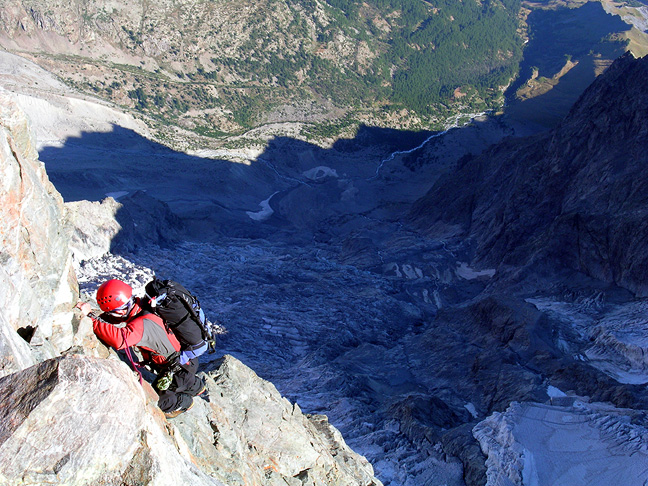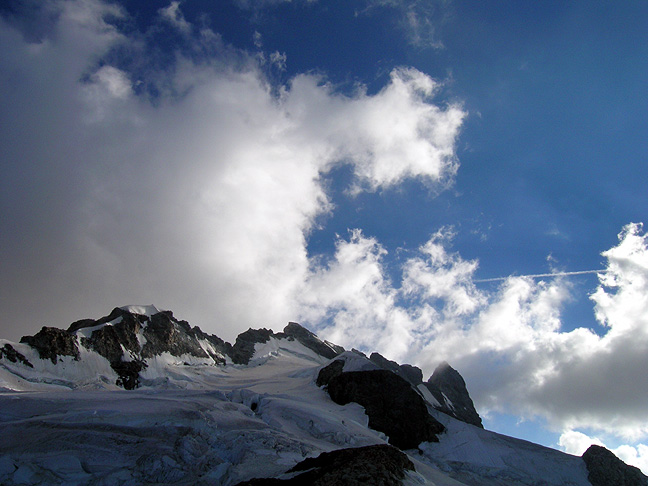
 |
|
| La Meije, Traverse |
| Difficulty Schedule Maximum
Ratio |
The Meije, like the Matterhorn or the Eiger, is one of those mythic summits in the Alps that lurks in the back of climbers' minds, never leaving them peace until they climb it. Like a giant wedge, the Meije is a long and very high ridge, not quite 4000 meters for much of its length, dominating the view from the small town of La Grave far below. This less crowded part of the Alps is know as the Massif des Écrins and is located just southwest of the Mont Blanc Massif, not far from Grenoble. On the Meije, the Traverse of the Arêtes is the route to do. This is a big route, complex with section of both rock and ice, over and around numerous towers with technical descents as well as challenging climbing. The Traverse starts from the Refuge du Promontoire at the bottom of the steep south buttress of the peak. From the hut we first climb the west end of the wedge and its highest summit, the Grand Pic. From here we descend steeply by rappel to the breche between the Grand Pic and the Dent Zsigmondy. This next unpronounceable tower is turned on its very steep north side, via an exposed and icy traverse. Regaining the ridge, we traverse the crest of the second, third and fourth towers, before finally climbing the Doigt de Dieu, the Finger of God, a wild looking tower at the east end of the long crest. From the Doigt, we descend, and with a few rappels reach the glacier and easier ground. Normally, we spend a second night at the Refuge de l'Aigle before tackling the long descent to the valley floor. There are two ways to approach the Refuge du Promontoire. The quicker is from La Grave, riding the lift and hiking and then climbing over the steep and challenging Breche de la Meije. This is a big climb in itself and also require that the route be in good conditions, with adequate snow cover, as there is some risk from rockfall on the south side of the Breche if it is too dry. Slower, but more sure is the approach from La Bétarde, a small village to the south. This really is not longer on the approach day, but does take additional travel time, either at the front end or at the end of the climb, as Bétarde is far from the bottom of our descent route, so a bus ride is needed either before or after our climb. But the climb is well worth it. One of the the best of the classic routes in the Alps. |
||||
 |
|
| Just after the Cheval Rouge on the Meije. | |
Difficulty This is a big mountain route. The first ascent, back in 1877, was a tour de force, and ahead of its time. The climbing is varied, never very hard, but seldom easy either. It is one of those routes that require a full range of mountain skills and an ability to perform them efficiently and without error. The technical climbing is no harder than about 5.7 (on the Cheval Rouge) but we climb in mountain boots. There is some steep ice on the north side of the Dent Zsigmondy, but these sections are short. The main challenge is an ability to move quickly, all day long, on varied and complex terrain. Normally, the climb takes about 10 hours, hut to hut, but many climbers finish in the dark! Prerequisites Very strong rock climbing skills, a high level of fitness and ability to move quickly and safely on exposed but more moderate terrain. Combinations Though there are not good combination options from either the Refuge du Promontoire or the Refuge de l'Aigle (with the exception of the Pic Oriental of the Meije, a fine and somewhat easier climb from the refuge de l'Aigle) there are countless other great climbs in the Écrins massif. It is worth spending lots of time in this area, exploring its many hidden gems. |
||||
 |
|
| The Meije from the Refuge de l'Aigle | |
 |
Kathy Cosley & Mark Houston AMGA Certified • SNGM members All images, layout and text ©2004 Cosley & Houston Alpine Guides, All Rights Reserved |
|
Your Comments -
more info
|